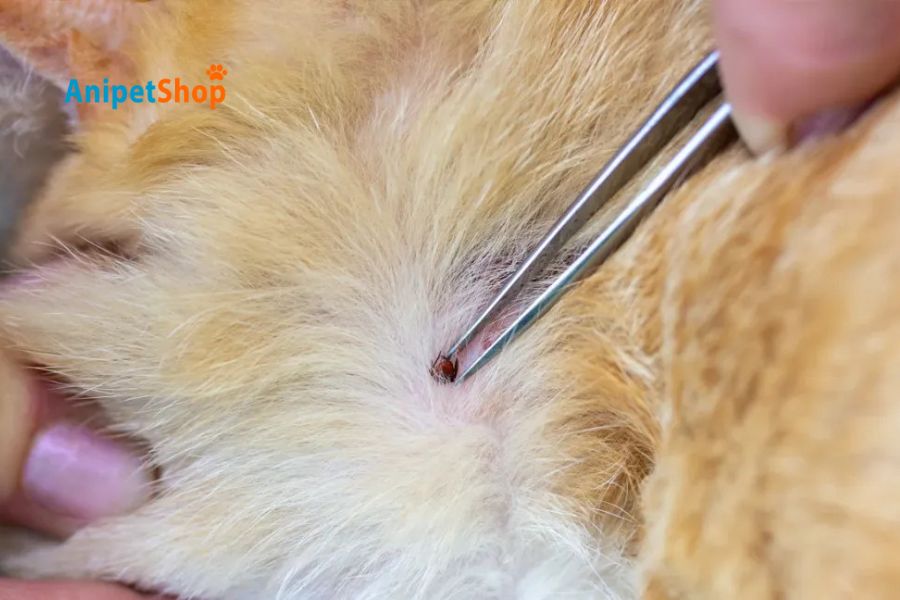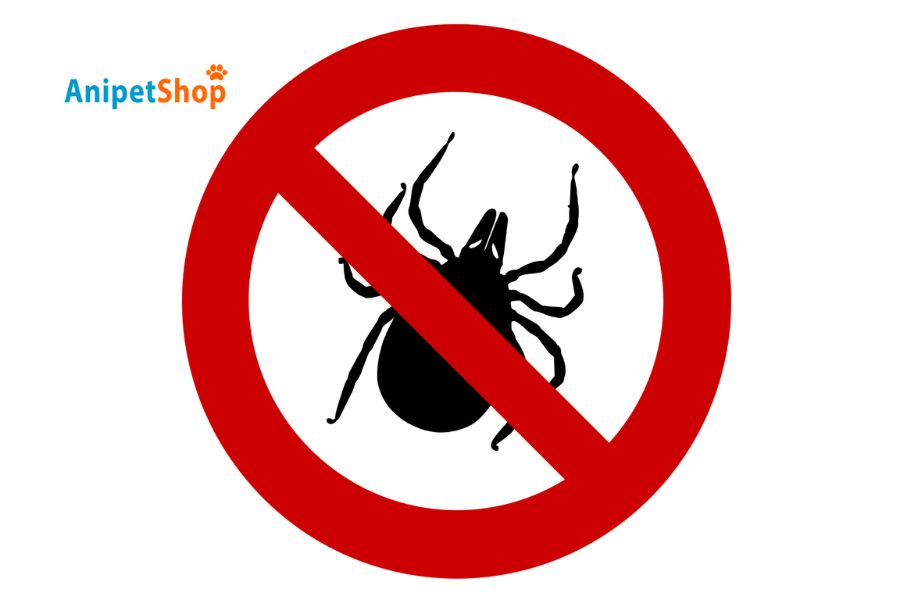Keep Your Dog Safe from Ticks: Detection, Removal, Prevention
Those afternoon walks in the park in your backyard can turn into a nightmare if your furry friend encounters a tick. These tiny bloodsuckers pose a big threat to dogs, carrying diseases that cause sickness and irritation to your beloved pet.
In this article we will equip you with the knowledge and tools to protect your dog from ticks.

Understanding Ticks
1. What is a Tick?

Ticks are external parasites that suck the blood of animal hosts, including dogs. They come in various shapes and sizes, often appearing as brown or reddish-brown bumps. Common types of ticks found on dogs are deer ticks, brown dog ticks, and American dog ticks.
Ticks latch onto their hosts while they brush through tall grass or wooded areas. Their bite can transmit a range of diseases, including Lyme disease, babesiosis, and ehrlichiosis.
2. Symptoms that your dogs are bitten by ticks
Not all tick bites show immediate signs. However, keep an eye out for:
-
- Redness, bumps, or swelling around the bite area
- Lethargy, loss of appetite, or fever
- Difficulty walking, limping, or joint pain
- Pale gums, weakness, or dark-colored urine
These symptoms might not appear for weeks or even months after the bite.
How to Check Your Dog for Ticks

Regular tick checks are crucial. Here’s a step-by-step guide to follow:
1. The Pre-Check Prep
Before you begin your tick inspection, grab a brush. Gently groom your dog, paying special attention to areas with loose fur. This helps dislodge any loosely attached ticks that haven’t burrowed in yet.
2. Head and Ears: Prime Tick Territory
Ticks love a good blood supply, so start your inspection at the head and ears. Here’s where to focus:
-
- Around the eyes: Gently lift your dog’s eyelids and check the delicate under-eye area.
- Between the folds of the ears: Ticks love to hide in these warm, moist crevices.
- Around the lips and muzzle: Don’t forget to peek inside the mouth for any unwelcome visitors
3. Neck, Chest, and Legs: A Thorough Examination
Now, we move on to a more detailed body scan. Here’s what to watch out for:
-
- The neck: Feel along the entire neck area, checking for any bumps or irregularities.
- The chest: Run your hands over your dog’s chest, paying close attention to the armpits, a favorite tick hangout.
- The legs: Carefully examine all four legs, including between the toes and around the paw pads.
4. The Tail and Rear End: A Final Sweep
Almost done! Lift your dog’s tail and inspect the base and underside thoroughly. Ticks love to burrow in these warm, hidden areas.
5. Finding a Tick: Removal vs. Monitoring?
If you find a tick, remove it immediately with a tick removal tool as discussed above. Don’t attempt to crush or squeeze the tick, as this can release harmful bacteria.
Safe Tick Removal

While you might be tempted to just yank the tick off, this can be risky. Tick removal tools offer a controlled and effective way to remove the tick whole, reducing the risk of infection. Here are two popular options:
Tick Hooks:
-
- Pros: Easy to use, affordable, and good for removing embedded ticks.
- Cons: Might not be suitable for very small ticks.
- How to Use: Slide the curved end of the hook under the tick’s body, close to your dog’s skin. Gently twist the hook upwards until the tick releases its hold.
Tick Tweezers:
-
- Pros: Offer good precision for grasping small ticks.
- Cons: Require a bit more technique to use effectively.
- How to Use: Grasp the tick’s head (the part attached to your dog’s skin) with the tweezers. Apply steady, gentle pressure and pull upwards in a slow, straight motion. Avoid squeezing the tick’s body.
Aftercare: Keeping Your Dog Healthy
Once you’ve successfully removed the tick, dab the bite area with a mild antiseptic solution or rubbing alcohol to help prevent infection. Also, remember to keep an eye on the bite area for redness, swelling, or pus formation, which could indicate infection.
Preventing Tick Bites on Your Dog

Prevention is always better than cure. Explore these year-round options:
-
- Prescription tick preventatives: Available in various forms (topical treatments, oral medications). Talk to your vet to choose the best option for your dog’s lifestyle.
- Natural prevention methods: While not foolproof, some natural options may offer some protection. Note: Always consult your veterinarian before using any essential oils or herbal remedies on your dog, as some can be toxic.
When to See a Veterinarian

Seek immediate veterinary care if your dog shows any signs of serious tick-borne illness, such as:
-
- Difficulty Breathing: This could indicate a reaction to a tick toxin or an allergic reaction to the bite itself.
- Seizures: Neurological problems can be a symptom of some tick-borne diseases.
- Severe Lethargy or Weakness: Excessive tiredness or an inability to stand or walk normally can signal a serious tick-borne illness.
A vet visit is a wise move even if you haven’t spotted a tick on your dog. This is a great opportunity to discuss preventative medication. Your veterinarian can recommend the most appropriate tick preventative medication for your dog’s lifestyle and risk factors.
FAQs
What should I do if I find ticks on my dog?
If you discover ticks on your dog, stay calm and follow these steps:
-
- Remove the tick: Use a tick removal tool and gently extract it. Don’t attempt to squish or squeeze the tick.
- Clean the bite area: Apply a mild antiseptic solution to the bite site.
- Monitor your dog: Watch for any signs of infection or changes in behavior that might indicate tick-borne illness.
- Consult your vet: Schedule an appointment to discuss the tick and potential preventative measures for your dog.
Should I be worried if I found a tick on my dog?
Finding a tick on your dog warrants attention, but it doesn’t necessarily mean cause for alarm. While some tick species carry diseases, not all bites will transmit illness. However, it’s crucial to remove the tick swiftly and keep an eye on your dog for any signs of discomfort or illness.
What kills ticks on dogs immediately?
Over-the-counter products like tick sprays or powders might advertise immediate tick kill. However, their effectiveness can vary, and some may not be safe for your dog. It’s best to consult your veterinarian for recommended tick prevention medications or safe removal methods.
Is a tick on a tick harmful?
A tick itself isn’t inherently harmful. However, the diseases it can transmit pose a serious threat. Common tick-borne illnesses in dogs include Lyme disease, babesiosis, and ehrlichiosis, which can cause a range of health problems.
How long will a tick stay on a tick?
An unfed tick can live for months in the environment, waiting for a host. Once attached to your dog, it will feed for several days to a week before detaching and laying eggs. Early detection and removal are crucial to prevent disease transmission.
What happens if a dog is left with a tick head?
Ideally, the entire tick should be removed during extraction. If the head gets left behind, it usually doesn’t pose a significant health risk. However, the embedded part might cause irritation or infection. It’s best to monitor the area and consult your vet if you notice any redness, swelling, or pus formation.
Conclusion
By understanding ticks and taking proactive measures, you can significantly reduce the risk of tick-borne diseases in your dog. Regular checks, safe tick removal practices, and preventative measures are your key weapons in keeping your furry friend safe and tick-free.
Lily Watson is an author specializing in veterinary care in Australia. With a profound passion for animal welfare and a solid foundation in veterinary science, Lily has dedicated herself to disseminating valuable knowledge and information for both pet owners and professionals in this field.

